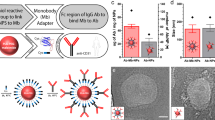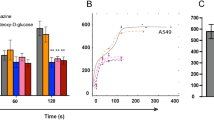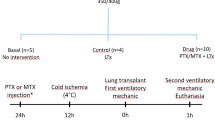Abstract
Modern medicine seeks precision targeting, imaging and therapy to maximize efficacy and avoid toxicities. Nanoparticles (NPs) have tremendous yet unmet clinical potential to carry and deliver imaging and therapeutic agents systemically with tissue precision. But their size contributes to rapid scavenging by the reticuloendothelial system and poor penetration of key endothelial cell (EC) barriers, limiting target tissue uptake, safety and efficacy. Here we discover the ability of the EC caveolae pumping system to outpace scavenging and deliver NPs rapidly and specifically into the lungs. Gold and dendritic NPs are conjugated to antibodies targeting caveolae of the lung microvascular endothelium. SPECT-CT imaging and biodistribution analyses reveal that rat lungs extract most of the intravenous dose within minutes to achieve precision lung imaging and targeting with high lung concentrations exceeding peak blood levels. These results reveal how much ECs can both limit and promote tissue penetration of NPs and the power and size-dependent limitations of the caveolae pumping system. This study provides a new retargeting paradigm for NPs to avoid reticuloendothelial system uptake and achieve rapid precision nanodelivery for future diagnostic and therapeutic applications.
This is a preview of subscription content, access via your institution
Access options






Similar content being viewed by others
Data availability
The data supporting the findings of this study are available within the article, Supplementary Information and Source Data files. Other relevant data are available for research purposes from the corresponding authors upon request. Source data are provided with this paper.
References
Schnitzer, J. E. Vascular targeting as a strategy for cancer therapy. N. Engl. J. Med. 339, 472–474 (1998).
Shuvaev, V. V., Brenner, J. S. & Muzykantov, V. R. Targeted endothelial nanomedicine for common acute pathological conditions. J. Control. Release 219, 576–595 (2015).
Mitchell, M. J. et al. Engineering precision nanoparticles for drug delivery. Nat. Rev. Drug Discov. 20, 101–124 (2021).
Poon, W., Kingston, B. R., Ouyang, B., Ngo, W. & Chan, W. C. W. A framework for designing delivery systems. Nat. Nanotechnol. 15, 819–829 (2020).
Li, J. & Kataoka, K. Chemo-physical strategies to advance the in vivo functionality of targeted nanomedicine: the next generation. J. Am. Chem. Soc. 143, 538–559 (2021).
Blanco, E., Shen, H. & Ferrari, M. Principles of nanoparticle design for overcoming biological barriers to drug delivery. Nat. Biotechnol. 33, 941–951 (2015).
Thomas, O. S. & Weber, W. Overcoming physiological barriers to nanoparticle delivery—are we there yet? Front. Bioeng. Biotechnol. 7, 415 (2019).
Xu, S., Olenyuk, B. Z., Okamoto, C. T. & Hamm-Alvarez, S. F. Targeting receptor-mediated endocytotic pathways with nanoparticles: rationale and advances. Adv. Drug Deliv. Rev. 65, 121–138 (2013).
Steichen, S. D., Caldorera-Moore, M. & Peppas, N. A. A review of current nanoparticle and targeting moieties for the delivery of cancer therapeutics. Eur. J. Pharm. Sci. 48, 416–427 (2013).
Park, K. Transcending nanomedicine to the next level: are we there yet? J. Control. Release 298, 213 (2019).
Sun, D., Zhou, S. & Gao, W. What went wrong with anticancer nanomedicine design and how to make it right. ACS Nano 14, 12281–12290 (2020).
van der Meel, R., Lammers, T. & Hennink, W. E. Cancer nanomedicines: oversold or underappreciated? Expert Opin. Drug Deliv. 14, 1–5 (2017).
Kim, S. M., Faix, P. H. & Schnitzer, J. E. Overcoming key biological barriers to cancer drug delivery and efficacy. J. Control. Release 267, 15–30 (2017).
Wilhelm, S. et al. Analysis of nanoparticle delivery to tumours. Nat. Rev. Mater. 1, 16014 (2016).
Schnitzer, J. E. Update on the cellular and molecular basis of capillary permeability. Trends Cardiovasc. Med. 3, 124–130 (1993).
Park, K. The beginning of the end of the nanomedicine hype. J. Control. Release 305, 221–222 (2019).
Dai, Q. et al. Quantifying the ligand-coated nanoparticle delivery to cancer cells in solid tumors. ACS Nano 12, 8423–8435 (2018).
Cheng, Y. H., He, C., Riviere, J. E., Monteiro-Riviere, N. A. & Lin, Z. Meta-analysis of nanoparticle delivery to tumors using a physiologically based pharmacokinetic modeling and simulation approach. ACS Nano 14, 3075–3095 (2020).
Sheth, V., Wang, L., Bhattacharya, R., Mukherjee, P. & Wilhelm, S. Strategies for delivering nanoparticles across tumor blood vessels. Adv. Funct. Mater. 31, 2007363 (2021).
Gu, L., Zhang, F., Wu, J. & Zhuge, Y. Nanotechnology in drug delivery for liver fibrosis. Front. Mol. Biosci. 8, 804396 (2021).
Athanasopoulou, F., Manolakakis, M., Vernia, S. & Kamaly, N. Nanodrug delivery systems for metabolic chronic liver diseases: advances and perspectives. Nanomedicine 18, 67–84 (2023).
Ghitescu, L., Fixman, A., Simionescu, M. & Simionescu, N. Specific binding sites for albumin restricted to plasmalemmal vesicles of continuous capillary endothelium: receptor-mediated transcytosis. J. Cell Biol. 102, 1304–1311 (1986).
Schnitzer, J. E., Oh, P., Pinney, E. & Allard, J. Filipin-sensitive caveolae-mediated transport in endothelium: reduced transcytosis, scavenger endocytosis, and capillary permeability of select macromolecules. J. Cell Biol. 127, 1217–1232 (1994).
Griffin, N. M. et al. Label-free, normalized quantification of complex mass spectrometry data for proteomic analysis. Nat. Biotechnol. 28, 83–89 (2010).
Durr, E. et al. Direct proteomic mapping of the lung microvascular endothelial cell surface in vivo and in cell culture. Nat. Biotechnol. 22, 985–992 (2004).
Massey, K. A. & Schnitzer, J. E. Targeting and imaging signature caveolar molecules in lungs. Proc. Am. Thorac. Soc. 6, 419–430 (2009).
Oh, P. et al. Subtractive proteomic mapping of the endothelial surface in lung and solid tumours for tissue-specific therapy. Nature 429, 629–635 (2004).
Oh, P. et al. In vivo proteomic imaging analysis of caveolae reveals pumping system to penetrate solid tumors. Nat. Med. 20, 1062–1068 (2014).
Schnitzer, J. E., McIntosh, D. P., Dvorak, A. M., Liu, J. & Oh, P. Separation of caveolae from associated microdomains of GPI-anchored proteins. Science 269, 1435–1439 (1995).
Carver, L. A. & Schnitzer, J. E. Caveolae: mining little caves for new cancer targets. Nat. Rev. Cancer 3, 571–581 (2003).
Schnitzer, J. E., Oh, P., Jacobson, B. S. & Dvorak, A. M. Caveolae from luminal plasmalemma of rat lung endothelium: microdomains enriched in caveolin, Ca(2+)-ATPase, and inositol trisphosphate receptor. Proc. Natl Acad. Sci. USA 92, 1759–1763 (1995).
Schnitzer, J. E., Oh, P. & McIntosh, D. P. Role of GTP hydrolysis in fission of caveolae directly from plasma membranes. Science 274, 239–242 (1996).
Oh, P., McIntosh, D. P. & Schnitzer, J. E. Dynamin at the neck of caveolae mediates their budding to form transport vesicles by GTP-driven fission from the plasma membrane of endothelium. J. Cell Biol. 141, 101–114 (1998).
Schnitzer, J. E. Caveolae: from basic trafficking mechanisms to targeting transcytosis for tissue-specific drug and gene delivery in vivo. Adv. Drug Deliv. Rev. 49, 265–280 (2001).
Oh, P. et al. Live dynamic imaging of caveolae pumping targeted antibody rapidly and specifically across endothelium in the lung. Nat. Biotechnol. 25, 327–337 (2007).
Chrastina, A., Valadon, P., Massey, K. A. & Schnitzer, J. E. Lung vascular targeting using antibody to aminopeptidase P: CT-SPECT imaging, biodistribution and pharmacokinetic analysis. J. Vasc. Res. 47, 531–543 (2010).
McIntosh, D. P., Tan, X. Y., Oh, P. & Schnitzer, J. E. Targeting endothelium and its dynamic caveolae for tissue-specific transcytosis in vivo: a pathway to overcome cell barriers to drug and gene delivery. Proc. Natl Acad. Sci. USA 99, 1996–2001 (2002).
Carver, L. & Schnitzer, J. in Biomedical Aspects of Drug Targeting (eds Muzykantov, V. R. & Torchilin, V. P.) 107–128 (Springer Science+Business Media, 2002).
Valadon, P. et al. Designed auto-assembly of nanostreptabodies for rapid tissue-specific targeting in vivo. J. Biol. Chem. 285, 713–722 (2010).
Schnitzer, J. E. in Whole Organ Approaches to Cellular Metabolism: Permeation, Cellular Uptake, and Product Formation (eds Bassingthwaighte, J. B. et al.) 31–69 (Springer New York, 1998).
Kadam, A. H. et al. Targeting caveolae to pump bispecific antibody to TGF-beta into diseased lungs enables ultra-low dose therapeutic efficacy. PLoS ONE 17, e0276462 (2022).
Vallabhajosula, S., Killeen, R. P. & Osborne, J. R. Altered biodistribution of radiopharmaceuticals: role of radiochemical/pharmaceutical purity, physiological, and pharmacologic factors. Semin. Nucl. Med. 40, 220–241 (2010).
Cavina, L. et al. Design of radioiodinated pharmaceuticals: structural features affecting metabolic stability towards in vivo deiodination. Eur. J. Org. Chem. 2017, 3387–3414 (2017).
Nagarajah, J., Janssen, M., Hetkamp, P. & Jentzen, W. Iodine symporter targeting with (124)I/(131)I theranostics. J. Nucl. Med. 58, 34s–38s (2017).
Bruns, R. R. & Palade, G. E. Studies on blood capillaries. II. Transport of ferritin molecules across the wall of muscle capillaries. J. Cell Biol. 37, 277–299 (1968).
Bundgaard, M. Vesicular transport in capillary endothelium: does it occur? Fed. Proc. 42, 2425–2430 (1983).
Severs, N. J. Caveolae: static inpocketings of the plasma membrane, dynamic vesicles or plain artifact? J. Cell Sci. 90, 341–348 (1988).
Thomsen, P., Roepstorff, K., Stahlhut, M. & van Deurs, B. Caveolae are highly immobile plasma membrane microdomains, which are not involved in constitutive endocytic trafficking. Mol. Biol. Cell 13, 238–250 (2002).
McIntosh, D. P. & Schnitzer, J. E. Caveolae require intact VAMP for targeted transport in vascular endothelium. Am. J. Physiol. Heart Circ. Physiol. 277, H2222–H2232 (1999).
Schnitzer, J. E., Allard, J. & Oh, P. NEM inhibits transcytosis, endocytosis, and capillary permeability: implication of caveolae fusion in endothelia. Am. J. Physiol. 268, H48–H55 (1995).
Schnitzer, J. E., Liu, J. & Oh, P. Endothelial caveolae have the molecular transport machinery for vesicle budding, docking, and fusion including VAMP, NSF, SNAP, annexins, and GTPases. J. Biol. Chem. 270, 14399–14404 (1995).
Stan, R. V., Kubitza, M. & Palade, G. E. PV-1 is a component of the fenestral and stomatal diaphragms in fenestrated endothelia. Proc. Natl Acad. Sci. USA 96, 13203–13207 (1999).
Shuvaev, V. V. et al. Spatially controlled assembly of affinity ligand and enzyme cargo enables targeting ferritin nanocarriers to caveolae. Biomaterials 185, 348–359 (2018).
Yu, M. & Zheng, J. Clearance pathways and tumor targeting of imaging nanoparticles. ACS Nano 9, 6655–6674 (2015).
BioReady™ 40 nm Carboxyl Gold Covalent Conjugation Protocol (nanoComposix, Fortis Life Sciences, 2024); https://cdn.shopify.com/s/files/1/0257/8237/files/BioReady_40_nm_Carboxyl_Gold_Conjugation_Protocol_v2.1.pdf?v=1670554597
Acknowledgements
We thank C. Ditterich for assistance with paper writing. We thank nanoComposix for help with TEM. This study was supported by the National Institutes of Health (https://www.nih.gov/grantsfunding) through grants awarded to J.E.S. (P01HL119165, R01CA169644 and R01HL169760). The funders had no role in study design, data collection and analysis, decision to publish or preparation of the paper.
Author information
Authors and Affiliations
Contributions
J.E.S. conceived the study. T.R.N., A.C., M.D.L., B.O. and J.E.S. designed the study. R.Y. and B.C. conducted antibody expression, purification, ELISA and western blotting. T.B. performed site-directed mutagenesis. A.C. prepared and performed SPECT-CT imaging and biodistribution studies of radioimmunoconjugates of PAMAM dendrimers and dendrons. O.C.-R. characterized and purified starting material antibodies. T.R.N. prepared GNP nanoimmunoconjugates. T.R.N. and O.C.-R. characterized GNP nanoimmunoconjugates. T.R.N. characterized GNP radio-nanoimmunoconjugates. T.R.N., A.C. and J.V. performed in vivo SPECT-CT imaging. A.C. and T.R.N. conducted the ex vivo biodistribution study. J.V. and T.R.N. conducted the ICP-MS study. T.R.N. and A.C. collected all data. J.K. conducted statistical analyses. T.R.N., A.C. and J.E.S. wrote the paper. M.D.L. and B.O. revised the paper. All authors read and edited the paper.
Corresponding author
Ethics declarations
Competing interests
The authors declare no competing interests.
Peer review
Peer review information
Nature Nanotechnology thanks the anonymous reviewers for their contribution to the peer review of this work.
Additional information
Publisher’s note Springer Nature remains neutral with regard to jurisdictional claims in published maps and institutional affiliations.
Extended data
Extended Data Fig. 1 Functionalization of PAMAM G5 dendrimers with APP2 Fab to form supramolecular nanoassembly.
PAMAM G5 were biotinylated using NHS-PEG4-biotin then radiolabeled with N-succinimidyl-3-(4-hydroxy-3-[125I]iodophenyl)propionate and terminated with glycidol. To form supramolecular nanoassembly, the biotinylated 125I labeled PAMAM G5 dendrimers were then noncovalently functionalized with trivalent APP2 streptabodies via streptavidin (SAV)-biotin linkage.
Extended Data Fig. 2 Characterization of Gold Nanoparticles (GNPs).
Size exclusion chromatography (SEC-UV) of unconjugated antibody, GNP and GNP immunoconjugates as indicated in color legend. The UV traces (λabs = 280 nm) show high purity of the samples and absence of high and low molecular weight contaminants.
Extended Data Fig. 3 Functionalization of gold nanoparticles with radioiodinated mAPP2.
PEG-Carboxilic acid terminated gold nanopartilces were conjugated to mAPP2 antibody as described in Methods. EDC: 1-ethyl-3-(3-dimethylamino) propyl carbodiimide, NHS: N-hydroxysulfosuccinimide.
Extended Data Fig. 4 Western blot validation of antibody specificity towards rat APP2.
Membranes, containing (1) 50 ng recombinant rat APP2 protein (aa2-648 + 6XHIS), (2) 30 μg rat lung homogenate, and (3) 30 μg purified plasma membrane fraction of rat lung-derived endothelial cells, probed with mAPP2 and non-specific, mutated mAPP2X show distinct difference in target recognition. mAPP2X shows no binding to rat APP2 nor any native rat lung proteins.
Source data
Source Data Fig. 1
Biodistribution data for Fig. 1.
Source Data Fig. 3
ROI analysis data for Fig. 3.
Source Data Fig. 4
Biodistribution data for Fig. 4.
Source Data Fig. 5
Target indices data for Fig. 5.
Source Data Fig. 6
Biodistribution and targeting indices for Figs. 4–6 and ICP-MS data for Fig. 6.
Rights and permissions
Springer Nature or its licensor (e.g. a society or other partner) holds exclusive rights to this article under a publishing agreement with the author(s) or other rightsholder(s); author self-archiving of the accepted manuscript version of this article is solely governed by the terms of such publishing agreement and applicable law.
About this article
Cite this article
Nayak, T.R., Chrastina, A., Valencia, J. et al. Rapid precision targeting of nanoparticles to lung via caveolae pumping system in endothelium. Nat. Nanotechnol. 20, 144–155 (2025). https://doi.org/10.1038/s41565-024-01786-z
Received:
Accepted:
Published:
Issue Date:
DOI: https://doi.org/10.1038/s41565-024-01786-z



